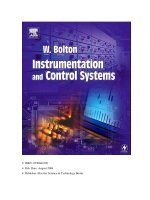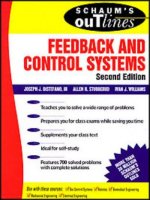Lecture Exploring management - Chap 6: Controls and control systems
Bạn đang xem bản rút gọn của tài liệu. Xem và tải ngay bản đầy đủ của tài liệu tại đây (708 KB, 24 trang )
Exploring Management
Chapter 6
Controls and
Control Systems
Chapter 6
•
•
•
How and why do managers use the
control process?
What types of controls are used by
managers?
What are some useful organizational
control tools and techniques?
6.1
Control
•
•
•
•
•
Controlling is one of the four management
functions.
Control begins with objectives and
standards.
Control measures actual performance
Control compares results with objectives
and standards.
Control takes corrective action as needed.
CONTROL
Control as a Management
Controlling is the process of measuring
Function
•
performance and taking action to ensure
desired results.
CONTROL
Control Process
Step 1:
Control starts with
objectives and
standards
–
–
Output standards
measure results in
terms of quantity,
quality, cost or time
Input standards
measure the work
efforts that go into the
CONTROL
Control Process
Step 2:
Control measures actual
performance
–
–
Agreed-upon standards
Accurate and timely
measurement
CONTROL
Control Process
Step 3:
Control compares results
with objectives and
standards
Desired Performance
- Actual Performance
Need for action
CONTROL
Control Process
Step 4:
Control takes corrective
action as needed
–
Management by
exception is the
practice of giving
attention to situations
that show the greatest
need
6.2
How Managers Use Control
•
•
•
Managers use feedforward, concurrent
and feedback controls
Managers use both internal and external
controls
Management by objectives is a way of
integrating planning and controlling
HOW MANAGERS USE CONTROL
Types of Controls
•
Organizations are open systems that
interact with environment with input,
throughput and output controls
HOW MANAGERS USE CONTROL
Types of Controls
HOW MANAGERS USE CONTROL
Internal and External Controls
•
Internal Control
–
Motivated employees exercise self-control in
their work
–
Participation in planning work and having a
sense of purpose facilitate motivation
HOW MANAGERS USE CONTROL
Internal and External Controls
External Control
HOW MANAGERS USE CONTROL
Objectives
Management By Objectives (MBO)
•
Superior and subordinate jointly plan
objectives
HOW MANAGERS USE CONTROL
Objectives
•
Types of objectives
–
Improvement objectives state goals for
improvement in measurable terms
•
–
“increase sales by 5%”
Personal development objectives focus on
personal growth
•
“learn a second language”
6.3
Control Systems and
Techniques
Quality control is a foundation of modern
•
•
•
•
•
management
Gantt charts and CPM/PERT are used in
project management and control
Inventory controls help save costs
Breakeven analysis shows where
revenues will equal costs
Financial ratios and balanced scorecards
strengthen organizational controls
CONTROL SYSTEMS AND TECHNIQUES
Quality Control
•
Quality Control is increasingly important
for global competition
–
Total Quality Management
•
•
–
Commitment to quality
Striving for zero defects
Continuous Improvement
•
Always searching for new ways to improve work
quality and performance
CONTROL SYSTEMS AND TECHNIQUES
Project Management
Project Management
•
Responsibility for planning and control
of projects
CONTROL SYSTEMS AND TECHNIQUES
Project Management
Project Management Tools
•
Gantt Charts
•
CPM/PERT Charts
–
Critical Path
CONTROL SYSTEMS AND TECHNIQUES
Inventory Control
•
Inventory controls reduce inventory costs
–
Economic order quantity
•
–
Pre-determined amount of inventory is ordered
when current inventory reaches a certain level
Just-in-time scheduling
•
Inventory arrives exactly
when needed for production or sale
CONTROL SYSTEMS AND TECHNIQUES
Breakeven Analysis
•
Breakeven Point
–
•
is the point at which revenues equal costs
Breakeven Analysis
–
calculates the point at which sales revenues
cover costs.
How to Calculate a Breakeven Point
Breakeven Point = Fixed Costs / (Price - Variable Costs)
CONTROL SYSTEMS AND TECHNIQUES
Breakeven Analysis
Major Financial Ratios for
Organizational Control
Liquidity—measures ability to meet short-term obligations.
• Current Ratio =Current Assets/Current Liabilities
• Quick Ratio =Current Assets-Inventory/Current Liabilities
Higher is better: You want more assets and fewer liabilities
Leverage—measures use of debt.
• Debt Ratio = Total Debts/Total Assets
Lower is better: You want fewer debts and more assets.
Asset Management—measures asset and inventory efficiency.
• Asset Turnover = Sales/Total Assets
• Inventory Turnover = Sales/Average Inventory
Higher is better: You want more sales and fewer assets or lower
inventory.
Profitability
• Net Margin = Net Profit after Taxes/Sales
CONTROL SYSTEMS AND TECHNIQUES
Balanced Scorecard
•
Balanced Scorecards start with the
organizational mission and vision to build
goals and performance measures for
–
Financial performance
–
Customer satisfaction
–
Internal process improvement
–
Innovation and learning









